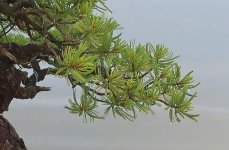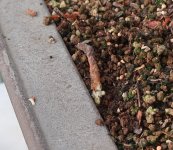clem
Chumono
hello, i'll show you the evolution of my recent acquisition, a japanese white pine from seed. I bought it this year, because i liked the shape of the trunk (tapper, curves + shari/uromiki) et i liked the branches too.
The tree shown in the website (Maillot Bonsai) ->




The tree is approx 55 cm high.
The tree in my garden in May ->
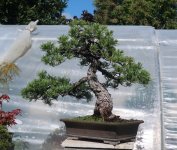
I removed the moss to let the soil dry out quicker and also to check the nebari ->

My projet (virtual) is to incline it more, to developp more the 1rst branch and maybe to enlarge the shari ->
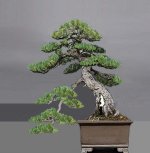
The tree in the middle of September ( 2 weeks ago) after a light wiring and styling to make it look better ->

The second branch on the right is weak, with no bud so it will probably die. But if it dies, i will keep a jin and use the branch above it to create a new branche (and replace it). Virtual ->

The tree 1 week ago : the right branch died and the old needles (grown 2 years ago) are yellow ->

The soil has some mycorrhizae, which is a very good point ->
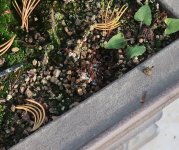
The 1rst branch (on the left) is weaker than the other parts of the tree. So i removed the old needles of the crown and branches (except the 1rst branch). I alos kept the dead branches into jins to get a wilder tree.
The crown before removing old needles ->

After ->

The 2 possible fronts (depending on which we want to show a conical base or more marked curves on the trunk) :
1rst front (larger base) ->

Second possible front (with a better movement of the trunk) ->

The tree outside with sunlight ->

Next year, i will keep the tree in that compact soil, because it has mycorrhizae, and because i want to restore more vigor to the 1rst branch.
I'm crossing my fingers that it stays in good shape/healthy because, obviously, i like it very much
because, obviously, i like it very much  .. I always wanted to buy a good JWP, a species that makes me dream of kokufu albums.
.. I always wanted to buy a good JWP, a species that makes me dream of kokufu albums.
The tree shown in the website (Maillot Bonsai) ->




The tree is approx 55 cm high.
The tree in my garden in May ->

I removed the moss to let the soil dry out quicker and also to check the nebari ->

My projet (virtual) is to incline it more, to developp more the 1rst branch and maybe to enlarge the shari ->

The tree in the middle of September ( 2 weeks ago) after a light wiring and styling to make it look better ->

The second branch on the right is weak, with no bud so it will probably die. But if it dies, i will keep a jin and use the branch above it to create a new branche (and replace it). Virtual ->

The tree 1 week ago : the right branch died and the old needles (grown 2 years ago) are yellow ->

The soil has some mycorrhizae, which is a very good point ->

The 1rst branch (on the left) is weaker than the other parts of the tree. So i removed the old needles of the crown and branches (except the 1rst branch). I alos kept the dead branches into jins to get a wilder tree.
The crown before removing old needles ->

After ->

The 2 possible fronts (depending on which we want to show a conical base or more marked curves on the trunk) :
1rst front (larger base) ->

Second possible front (with a better movement of the trunk) ->

The tree outside with sunlight ->

Next year, i will keep the tree in that compact soil, because it has mycorrhizae, and because i want to restore more vigor to the 1rst branch.
I'm crossing my fingers that it stays in good shape/healthy


